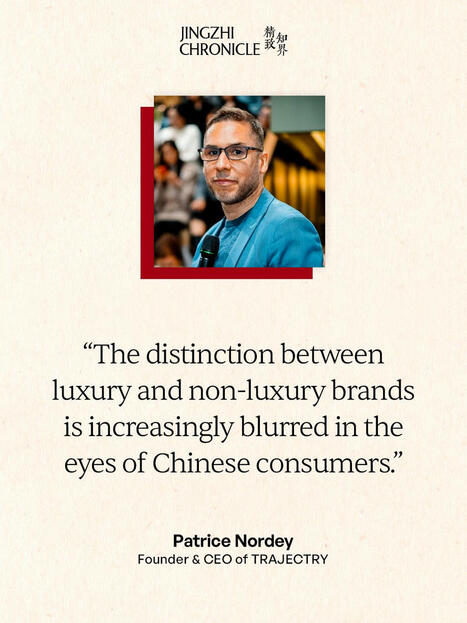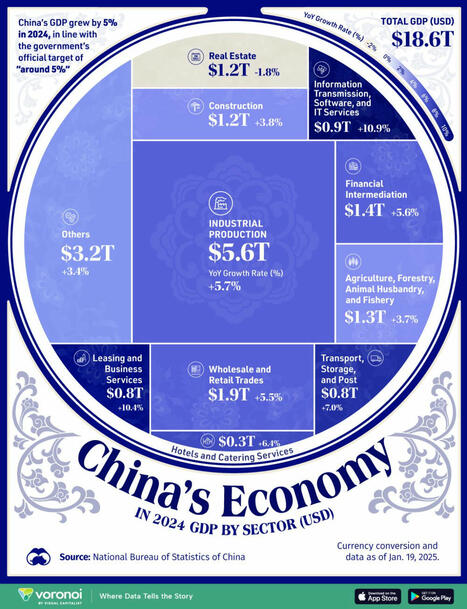 Your new post is loading...
 Your new post is loading...

|
Scooped by
Trevor Lee @ TravConsult
May 5, 7:16 AM
|
Brands struggle to reach Chinese consumers through traditional apps and websites. WeChat Mini Programs now serve over 450 million daily active users in China's biggest social platform.

|
Scooped by
Trevor Lee @ TravConsult
May 2, 7:48 PM
|
Three of China’s largest airlines announced their quarter one (Q1) 2025 results. #FlightFriday compares Air China, China Eastern Airlines, and China Southern Airlines' domestic flights versus international.

|
Scooped by
Trevor Lee @ TravConsult
April 30, 11:52 PM
|
Is China the last great hope for growth in the global wine industry?
The wine industry is reportedly in something of a funk.
Declining consumption here, oversupply there.
Many yearn for solutions from times gone by, which is my excuse to quote Bonnie Tyler - we're holding out for a hero.
Meanwhile in China, younger drinkers are taking things into their own hands and a number of forces are converging to drive change, and most importantly growth.
1. A shift to everyday consumption
Gen Z and Millennial Chinese consumers are moving away from the gifting/status model that fueled earlier wine booms.
Instead, they're integrating wine into regular social gatherings, weeknight meals, and casual meet-ups.
Wine is becoming less about displaying wealth and more about lifestyle and personal enjoyment.
2. Digital first discovery
Young Chinese wine enthusiasts are discovering new wines primarily through social platforms like RED (Xiaohongshu) and WeChat.
Live streamed tastings and virtual masterclasses have exploded in popularity.
3. Style preferences are evolving
While big banging reds traditionally dominated imports, younger consumers are showing broader palate preferences with a growing interest in lighter bodied reds from cooler climate regions.
Demand is surging for rosé and sparkling wines (particularly among female consumers) as well as aromatic white wines like Riesling and Gewürztraminer.
4. The home grown effect
Younger drinkers are now more comfortable with "made in China" and so there is an openness to Chinese made wine, particularly from Ningxia and Shandong regions.
5. Experience centered consumption
Wine bars featuring flights, tasting experiences, and food pairings are proliferating across tier-one and tier-two cities.
Young consumers prioritise the story and experience surrounding wine rather than just label recognition.
As a result, wine tourism (both domestic and international) is growing exponentially among affluent young professionals.
6. Health is the new wealth
The wellness conscious younger generation are showing a growing interest in organic and biodynamic wines.
As a result, sustainability credentials are increasingly important, with packaging innovation and environmental commitment becoming differentiators in a crowded market.
6. Chinese wine geeks
Knowledge hungry consumers are driving a thirst for wine education.
Refreshingly, young professionals increasingly view wine knowledge as both a personal interest and career advantage.
The implications for international wine producers in all of this are significant.
Success in today's Chinese market requires an authentic connection with consumers who are increasingly sophisticated and focused on experience.
The dragon is stirring.
Have we found our hero?
--------------------------------------------------
I'm Iain Langridge 毅安 and I use my experience in China to launch, grow, and manage premium consumer brands.
Follow or DM me to find out more.

|
Scooped by
Trevor Lee @ TravConsult
April 30, 11:49 PM
|
Travel Trends Gen Z’s Next Trip? A Hidden Experience, Not Viral Hotspot Temple retreats, secret food festivals, and offline cultural moments are supplanting mass tourism, finds Trip.com survey.

|
Scooped by
Trevor Lee @ TravConsult
April 30, 9:42 PM
|
China isn’t just consuming luxury—it’s rewriting its meaning. We recently spoke with Patrice Nordey, founder & CEO of TRAJECTRY, whose 25+ years in digital strategy and China market innovation give him a rare lens on what’s really changing.
“Luxury consumers are often misinterpreted simply as high spenders. But true prestige brands understand that their clients are seekers of taste and exclusivity,” says Nordey.
So what does the next chapter of luxury look like in China?
✨ From product-centric thinking to experience-first strategies: Chinese consumers—especially the younger elite—are shifting their spending toward travel, wellness, art, and design. Luxury is no longer just what you buy—it’s how it makes you feel, and how seamlessly it integrates into a lifestyle that is curated, intentional, and expressive.
✨ From global templates to culturally embedded storytelling: Imported prestige no longer guarantees relevance. Brands must build narratives that connect with Chinese cultural codes—from guochao pride to elite connoisseurship—and co-create with local communities to earn their place.
✨ From logos to jingzhi—refined discernment, cultural fluency, and individual meaning: Today’s luxury isn’t loud. It’s quiet precision, artistic integrity, and emotional depth. Jingzhi isn’t a trend—it’s a philosophy of living with taste, and a signal of identity for China’s rising creative class.
As the lines between status and meaning blur, brands that lead will be those that design with—not just for—China.
#JingzhiChronicle #JingzhiVisionReport #PatriceNordey #LuxuryInChina #Jingzhi #NeoLuxury #ConsumerShift #BrandStrategy #ChinaMarket #Guochao #DigitalLuxury #ExperienceDesign #LuxuryMarketing #CulturalStorytelling #JingzhiEconomy #NeoLuxury #Jingzhi

|
Scooped by
Trevor Lee @ TravConsult
April 23, 6:05 AM
|
Many brands struggle to use Chinese video marketing effectively despite its massive potential. China's video platforms now reach over 1 billion active users daily through apps like Douyin and Kuaishou.

|
Scooped by
Trevor Lee @ TravConsult
April 22, 12:34 AM
|
The evolution of coffee in China mirrors the broader transformation of the Chinese consumer landscape. Not long ago, ordering a coffee was less about the caffeine and more about the statement it made – a symbol of refined taste, aligned with global sophistication.

|
Scooped by
Trevor Lee @ TravConsult
April 20, 7:18 PM
|
The transformation of Chinese consumption habits is accelerating, with consumers poised to boost spending on leisure, entertainment and healthcare goods and services as they shift from basic material satisfaction to aspirational and personalized consumption, a new report said.

|
Scooped by
Trevor Lee @ TravConsult
April 20, 7:16 PM
|
As the May Day holiday approaches, Chinese travelers are showing a strong preference for short- and medium-haul overseas destinations, underscoring the burgeoning demand for a variety of travel experiences.

|
Scooped by
Trevor Lee @ TravConsult
April 17, 11:49 PM
|
China is battering down the hatches in anticipation of the eight-day travel rush for the May Day holiday beginning next week.

|
Scooped by
Trevor Lee @ TravConsult
April 16, 2:32 PM
|
China = world’s LARGEST car exporter. 🚗
Surpassing Japan & Germany! 🤯
In less than a decade, China has surged from underdog to leader in global auto exports.
--> Now shipping 6.4 million cars annually.
VS.
🇯🇵Japan - 4.22M
🇩🇪Germany - 3.18M
🇺🇸US - 1.43M
In 2020, China exported just 2M vehicle - a 220% increase in 4 years.
【What happened? 🤔】
While many Western automakers were still transitioning to EV, Chinese brands like BYD, NIO, and Geely went ALL-IN on EVs from the start.
With China’s advantages in battery production + supplier of lithium & rare earth materials + government support...
Here's today’s landscape:
- 60%+ of Chinese car exports were NEVs in 2023.
- Produces over 50%+ of the world’s EVs.
- Controls over 75% of global battery cell production capacity
Meanwhile, Tesla, once the *trailblazer* in electric vehicles, faces mounting challenges:
【Trade Turbulence 💥】
New U.S. tariffs on Chinese components have disrupted Tesla's production plans.
Especially for the Cybercab + Semi trucks
--> With tariffs escalating from 34% to a staggering 145%...
【Affordable EVs in Limbo 😳】
The anticipated $25k Tesla model aimed at mass-market appeal
It now remains uncertain.
Musk says producing a cheaper model without self-driving would be *pointless*. 😅
Chinese EV brands are now outselling Tesla in key markets like Southeast Asia + Latin America.
+ in Europe, the market share jumped from 6% in 2020 to 20% in 2024.
Who could challenge China’s throne? Let me know your thoughts!
Arnold Ma #China #Electricvehicles #Cars | 56 comments on LinkedIn

|
Scooped by
Trevor Lee @ TravConsult
April 15, 9:20 PM
|
(Yicai) April 7 -- Eight of the 28 Chinese provincial-level regions that have released population data for last year reported an increase in permanent residents, with the figure remaining unchanged in two and dropping for the rest.Guangdong, Zhejiang, Fujian, Hainan, Anhui, and Shaanxi provinces...

|
Scooped by
Trevor Lee @ TravConsult
April 15, 8:35 PM
|
Xiaohongshu's (#RedNote) latest update is the biggest sign yet that brands must treat this platform as a search engine driven by UGC. **Not** as a social media platform.
Posts can now include links in the comments section 🔗
The system will automatically generate a link when a product, trending topic or brand is mentioned that directs a user to a corresponding page (organized by the system) which includes all posts related to that
👇 The below example is a content creator who has made a beautiful video, in which she is highlighting a product from the brand Kuka
(her video by the way is a masterclass in how you should be working with influencers on Xiaohongshu but that’s for another post)
In the comments section, she mentions the product, this links to a page with hundreds of posts from other creators giving reviews about the product as well
I cannot overstate just how much features like this make Xiaohongshu (#RedNote) so vastly different from Western social media platforms (in their current state) and as such, require a completely different strategy + mindset to achieve success
|

|
Scooped by
Trevor Lee @ TravConsult
May 5, 5:43 AM
|
🛍️ While China’s domestic luxury spending took a 20% hit last year, the daigou trade actually grew by 5% in 2024. Savvy shoppers are increasingly using these personal shoppers abroad to score better deals and hard-to-find items that aren’t available in local boutiques.
🌏 Thanks to the weak yen, Chinese tourists are spending 120% more on luxury goods in Japan compared to pre-pandemic levels. Meanwhile, Hainan’s duty-free shops saw sales plummet by nearly a third as shoppers looked elsewhere.
⚔️ Luxury houses like LVMH are cracking down on daigou resellers to protect their pricing power, while Chinese authorities impose heavy fines (up to RMB 2 million) for tax evasion. But daigou sellers keep adapting - livestreaming their overseas shopping trips, or even pioneering “reverse daigou” to bring mainland Chinese goods into Hong Kong.
💎 For many Chinese consumers, their go-to daigou isn’t just a seller - they’re a personal shopping concierge. These relationships offer 20-30% savings on luxury goods and access to exclusive items like Hermès quota bags.
🔍 Want to understand how daigou is reshaping China’s luxury landscape? Read more here: https://lnkd.in/ehKe_C2
#LuxuryMarket #RetailTrends #Luxuryshopping #ChinaConsumer #Daigou

|
Scooped by
Trevor Lee @ TravConsult
May 1, 12:13 AM
|
Germany has taken over Australia as the second largest health foods exporter to China last year, trailing behind only the US.

|
Scooped by
Trevor Lee @ TravConsult
April 30, 11:50 PM
|
Temple retreats, secret food festivals, and offline cultural moments are supplanting mass tourism, finds Trip.com survey.

|
Scooped by
Trevor Lee @ TravConsult
April 30, 11:02 PM
|
Q1 data from China signals selective recovery, with tourism and e-commerce gaining traction. Meanwhile, luxury heavyweights like Kering and Valentino face continued pressure in Asia.

|
Scooped by
Trevor Lee @ TravConsult
April 30, 6:35 PM
|
As non-alcoholic wine rides a wave of popularity across Europe and North America, China is seeing its own boom — but for very different reasons.

|
Scooped by
Trevor Lee @ TravConsult
April 23, 5:42 AM
|
Dragon Trail’s spring 2025 survey of 1,022 Chinese travelers covers plans for outbound trips in 2025, top information sources and platforms for each stage of the journey, safety perceptions for 23 destinations, attitudes on sustainable travel, and more.

|
Scooped by
Trevor Lee @ TravConsult
April 20, 7:18 PM
|
As the economy slows and the trade war drags on, Chinese consumers are changing the way they spend. Whether on daily necessities or big-ticket purchases, caution is the dominant mood, but it’s not without signs of resilience and adaptability. ThinkChina’s Yi Jina finds out.

|
Scooped by
Trevor Lee @ TravConsult
April 20, 7:17 PM
|
A new initiative aims to boost the local economy by attracting elderly travellers to remote parts of the country.

|
Scooped by
Trevor Lee @ TravConsult
April 20, 7:14 PM
|
For decades, the travel desires of affluent Chinese mirrored a global script of status: the West represented success.…

|
Scooped by
Trevor Lee @ TravConsult
April 17, 3:34 AM
|
China Isn't Dead... But It's Different
Inside China’s $18.6 Trillion Economy
After 25 years living and working in China, I’ve learned never to underestimate the country’s ability to adapt.
Despite ongoing trade tensions with the U.S. and sluggish domestic demand, China’s economy grew 5% in 2024... right on target. What’s driving that growth?
Industry and tech.
Manufacturing still leads at $5.6 trillion, but what caught my eye is the 10.9% surge in the tech sector. That’s not just impressive, it’s strategic.
Chinese firms like Baidu, Inc. and DeepSeek are racing ahead in AI, and government support is accelerating the shift.
Meanwhile, real estate has stalled, dragged down by oversupply and mounting debt.
The real story? China isn’t slowing down. It’s pivoting.
While the West debates decoupling, China is quietly doubling down on sectors that will define the next decade: AI, advanced manufacturing, and digital infrastructure.
Ignore the headlines if you want. But I’ve seen this movie before... and every time people bet against China, they’re caught off guard by how fast it moves.
This isn’t just economic data. It’s a signal.
China is no longer the world’s factory. It’s becoming one of its biggest innovators.
And for anyone doing business globally, that changes everything.
What do you think of the shift?
Graphic courtesy of Visual Capitalist
#GlobalBusiness #China #Economy #GlobalTrade | 24 comments on LinkedIn

|
Scooped by
Trevor Lee @ TravConsult
April 16, 5:07 AM
|
Car rental is booming, and we're leading the way.
At our recent Car Business Partner Summit, we reaffirmed our commitment to both our partners and consumers, buoyed by a strong year of growth. In 2024, our rental orders nearly doubled, driven by a 40% increase in new users and growing customer loyalty.
This year, we're focusing on openness, efficiency, and AI to empower our partners and create seamless experiences for our consumers.
Swipe through the carousel for key market insights on our journey ahead.
#Fliggy #Travel #MarketInsights

|
Scooped by
Trevor Lee @ TravConsult
April 15, 9:16 PM
|
Number rose by almost 60% in a year to 49,691 stores, making China ‘a global coffee industry powerhouse’
|





 Your new post is loading...
Your new post is loading...



















![[Vox pop] Cash is king: The practical shift in Chinese spending habits | Chinese Travellers | Scoop.it](https://img.scoop.it/oY5zOxRG5oyQsXoibG7kMDl72eJkfbmt4t8yenImKBVvK0kTmF0xjctABnaLJIm9)








